预计到 2031 年,智能电表市场规模将从 2024 年的 262.1 亿美元增至 492.4 亿美元。预计该市场在 2025 年至 2031 年期间的复合年增长率为 9.8%。人工智能 (AI) 和机器学习 (ML) 的融合可能会在未来几年带来新的智能电表市场趋势。
智能电表市场分析
智能电网计划的兴起和智能电表普及率的提高正在推动全球对智能电表的需求。此外,减少非收入水损失的需求不断增长也加速了智能电表市场的增长。国际努力也在促进智能电表市场的增长。例如,2025 年 6 月有报道称,在联合国的支持下,印度尼西亚中部爪哇岛、马都拉岛和巴厘岛(人口超过 1.6 亿)的电网正在进行重大升级。这些改进旨在提高电网应对太阳能和风能等可再生能源波动的能力,彰显了全球向更智能、更具适应性的电力基础设施转变的趋势。
智能电表市场概览
智能电表是一种先进的数字设备,能够实时精确测量和记录电力、天然气或水等公用事业的消耗。与需要人工抄表且数据有限的传统模拟电表不同,智能电表通过安全的通信网络自动将使用情况数据传输给公用事业提供商。这种实时数据交换能够实现更高效的资源管理、更准确的计费和更优质的客户服务。此外,智能电表是公用事业管理数字化转型的关键组成部分。它们支持自动化,降低运营成本,并提供宝贵的消费洞察,帮助提供商和消费者做出明智的决策。公用事业公司可以使用智能电表数据进行需求预测、能源负载平衡和快速故障检测。同时,消费者可以从详细的使用情况报告和实时警报中受益,从而鼓励节能降耗。
自定义此报告以满足您的要求
您将免费获得任何报告的定制,包括本报告的部分内容,或国家级分析、Excel 数据包,以及为初创企业和大学提供超值优惠和折扣
智能电表市场: 战略洞察
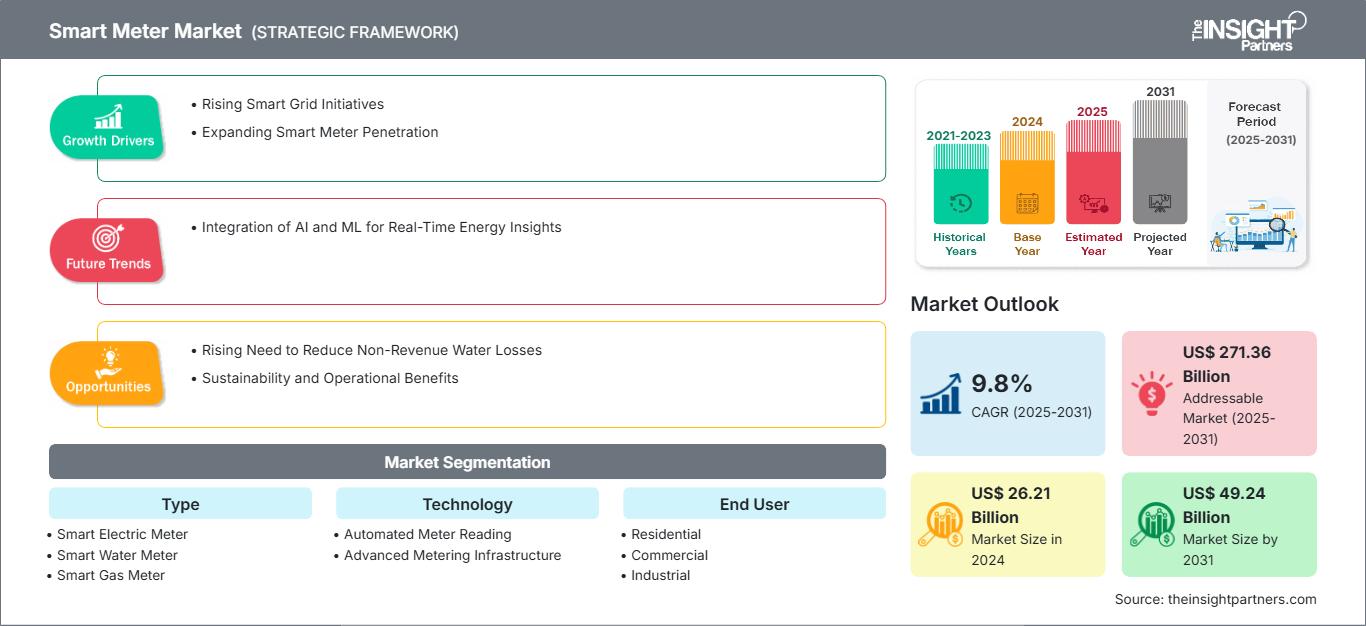
- 获取本报告的主要市场趋势。这个免费样本将包括数据分析,从市场趋势到估计和预测。
您将免费获得任何报告的定制,包括本报告的部分内容,或国家级分析、Excel 数据包,以及为初创企业和大学提供超值优惠和折扣
智能电表市场: 战略洞察

- 获取本报告的主要市场趋势。这个免费样本将包括数据分析,从市场趋势到估计和预测。
智能电表市场驱动力与机遇
可持续性与运营效益
智能电表的部署代表着一个战略机遇,可以推动环境和经济效益,尤其是在新兴市场。通过提供准确的实时能耗数据,智能电表使用户能够更高效地监控和管理其用电情况。这可以降低能耗、减少温室气体排放和碳足迹,直接有助于实现国家和国际气候目标。根据《巴黎协定》,乌兹别克斯坦正在积极推行脱碳举措,并得到了世界银行4625万美元的投资支持,旨在减少排放并进入国际碳市场。智能电表的实施在这一努力中发挥着至关重要的作用,预计到 2028 年将减少约 6000 万吨二氧化碳排放。
减少无收益水损失的需求日益增长
水务公司主要由家庭供水供应商组成,负责在联邦、州和市政各级严格监管的环境中安全高效地提供供水服务。这些公用事业公司通常在预算受限的情况下运营,这使得大量的资本投资变得困难。成本上升、基础设施老化和资金限制加剧了运营挑战,尤其是在管理用水和供水方面。
智能电表市场报告细分分析
促成智能电表市场分析的关键细分是类型、技术和最终用户。
- 根据类型,智能电表市场细分为智能电表、智能水表和智能燃气表。智能电表领域在 2024 年占据市场主导地位。
- 从技术角度来看,智能电表市场分为自动抄表和高级计量基础设施两大类。高级计量基础设施领域在 2024 年占据市场主导地位。
- 按最终用户划分,智能电表市场分为住宅、商业和工业。2024 年,住宅领域占据市场主导地位。
按地域划分的智能电表市场份额分析
智能电表市场分为五大区域:北美、欧洲、亚太地区、中东和非洲 (MEA) 以及南美和中美。2024 年,亚太地区占据市场主导地位。
由于快速的城市化、工业化和不断增长的能源需求,亚太地区对智能电表的需求不断增长。监管、经济和技术等多种因素共同推动着亚太地区各国采用和部署智能电表。其中最主要的是政府政策,其监管要求侧重于实现能源基础设施现代化、提高电网效率和推进可持续发展目标。许多司法管辖区已颁布立法,要求公用事业公司在规定的时间内从传统电表过渡到智能电表。
中国以及日本、韩国和台湾等其他东亚主要国家和地区一直处于亚太地区智能电表应用的前沿,推动着全国范围内的大规模推广,这是其迈向现代化能源管理和基础设施战略的一部分。2023年,自10月1日起,日本已允许企业访问智能电表的用电量数据,使企业能够开发创新服务。这项政策促进了公用事业公司收集的数据的利用,以创建应对脱碳和老年人护理监测等挑战的解决方案。同样,根据印度政府电力部的数据,印度在智能电表普及方面已达到一个重要里程碑,截至 2025 年 1 月,已部署超过 2000 万台智能消费电表。
智能电表市场报告范围
智能电表市场新闻及最新发展
智能电表市场的评估是通过收集一手和二手研究后的定性和定量数据进行的,这些数据包括重要的公司出版物、协会数据和数据库。智能电表市场的一些发展如下:
- Hubbell Incorporated 的子公司 Hubbell Incorporated(特拉华州)(统称“Hubbell”)收购了 Tessco Technologies Incorporated 的子公司 Ventev。Ventev 位于马里兰州蒂莫尼姆,是一家领先的制造商和提供商,提供用于供电、保护和连接无线网络的完整解决方案生态系统。 Ventev 拥有 20 年为通信行业设计、制造和交付无线解决方案的经验,这与 Hubbell 不断拓展的优质电气和公用事业产品组合形成天然的互补。
(来源:Hubbell,新闻稿,2025 年 2 月)
- 能源管理和自动化数字化转型领域的领导者施耐德电气宣布,其人工智能驱动的功能现已在 Wiser Home 应用程序上线。施耐德电气近期被评为全球最具可持续发展能力的公司,凭借尖端解决方案,继续引领智能家居能源管理,为房主、房屋建筑商和电气安装人员提供支持。施耐德的这项新功能是市场首创。它通过一个应用程序 Wiser Home,为家用热水器和电动汽车充电器这两个最大的电力负载提供人工智能优化的能源管理。Wiser Home 是施耐德电气的家庭能源管理解决方案,提供能源监控、控制和优化功能。该新功能完全由施耐德电气内部开发,通过针对用户需求的自动负载管理和预测性能源消耗调度来优化能源账单。
(来源:施耐德电气,新闻稿,2024 年 9 月)
智能电表市场报告覆盖范围和可交付成果
《智能电表市场规模和预测(2021-2031)》对市场进行了详细的分析,涵盖以下领域:
- 涵盖范围内所有主要细分市场的地区和国家级智能电表市场规模和预测
- 智能电表市场趋势以及市场动态,例如驱动因素、限制因素和关键机遇
- 详细的 PEST 和 SWOT 分析
- 智能电表市场分析,涵盖主要市场趋势、区域框架、主要参与者、法规和最新市场发展
- 行业格局和竞争分析,涵盖市场集中度、热图分析、知名参与者和智能电表市场的最新发展
- 详细的公司简介
智能电表市场区域洞察
The Insight Partners 的分析师已详尽阐述了预测期内影响智能电表市场的区域趋势和因素。本节还讨论了北美、欧洲、亚太地区、中东和非洲以及南美和中美洲的智能电表市场细分和地域分布。
智能电表市场报告范围
| 报告属性 | 细节 |
|---|---|
| 市场规模 2024 | US$ 26.21 Billion |
| 市场规模 2031 | US$ 49.24 Billion |
| 全球复合年增长率 (2025 - 2031) | 9.8% |
| 历史数据 | 2021-2023 |
| 预测期 | 2025-2031 |
| 涵盖的领域 |
By 类型
|
| 覆盖地区和国家 | 北美
|
| 市场领导者和主要公司简介 |
|
智能电表市场参与者密度:了解其对业务动态的影响
智能电表市场正在快速增长,这得益于终端用户需求的不断增长,而这些需求的驱动因素包括消费者偏好的不断变化、技术进步以及对产品优势的认知度不断提高。随着需求的增长,企业正在扩展其产品线,不断创新以满足消费者需求,并利用新兴趋势,从而进一步推动市场增长。
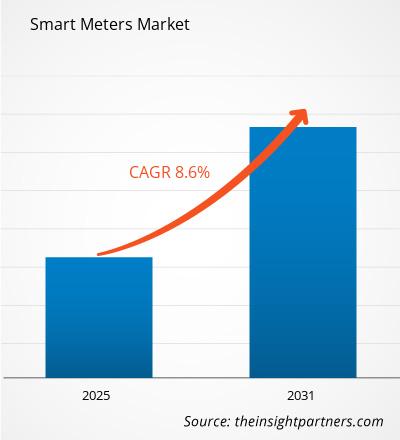
- 获取 智能电表市场 主要参与者概述
- 历史分析(2 年)、基准年、预测(7 年)及复合年增长率
- PEST和SWOT分析
- 市场规模、价值/数量 - 全球、区域、国家
- 行业和竞争格局
- Excel 数据集
近期报告
客户评价
购买理由
- 明智的决策
- 了解市场动态
- 竞争分析
- 客户洞察
- 市场预测
- 风险规避
- 战略规划
- 投资论证
- 识别新兴市场
- 优化营销策略
- 提升运营效率
- 顺应监管趋势












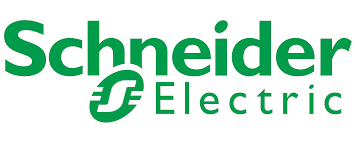


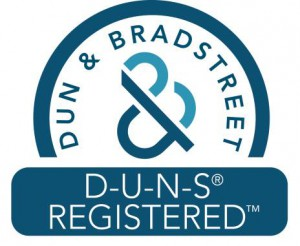
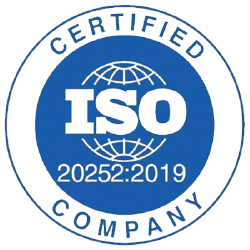



 获取免费样品 - 智能电表市场
获取免费样品 - 智能电表市场